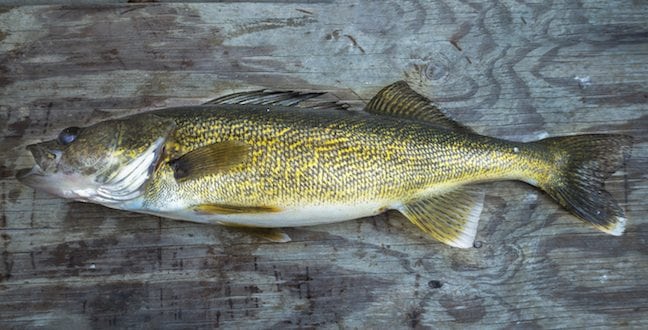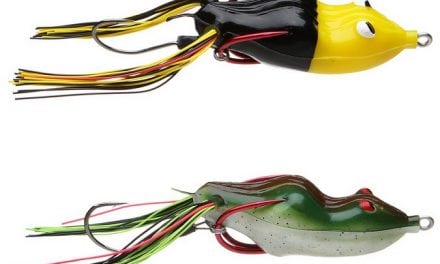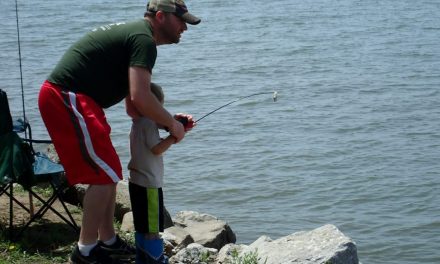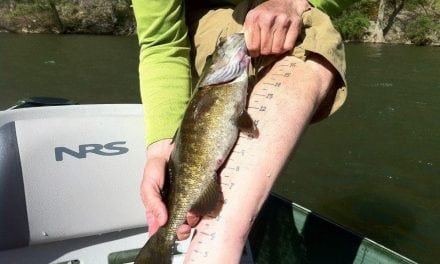That so-called “hunter’s moon” doesn’t affect just wildlife. Here’s how to use it to improve your fishing for walleyes.
It wasn’t my typical October outing.
Instead of gearing up with tree stands and archery gear, or throwing a shotgun and bird dog into the truck, I was towing a boat. There was a bird dog along, but Rascal, the little Brittany, looked somewhat perplexed as we glided across the lake into the now quickly descending autumn sun.

Don’t winterize and store the boat until you’ve given October’s full-moon walleyes a go. This year, the full moon falls on October 5. (Shutterstock image)
We were on the hunt, but for something different than the usual October sporting fare. Conditions were prime for fishing hard-feeding walleyes — a steady and mild weather pattern, water temperatures in the 50s … and a moon nearing full.
WHY FISH OCTOBER’S MOON?
Don’t winterize and store the boat until you’ve given October’s full-moon walleyes a go. This year, the full moon falls on October 5. Given clear skies for two to three days on each side of that date, the moon will shine bright enough to put hungry fall walleyes on the hunt for nighttime forage. And that makes for good fishing.
Look for mild conditions, with waters that are calm to carrying just a little chop. Early October usually sees plenty of evenings like those. Time your trip to be fishing your favorite walleye hole for the last hour of daylight and the first few hours spanning nightfall and moonrise.
A moon that’s full or nearly full offers fine walleye fishing in autumn, and the reasons are simple: The fish are hungry, and moonlight provides ideal conditions for the fish to hunt by.
In October, our waters have cooled off. Temperatures match about what they are in late May or early June — usually somewhere in the 50s and, of course, dropping. Those conditions will bring baitfish shallow, looking for warmer environs, with marble-eyes following to hunt their forage in the moonlit waters.
LAKE LOCATIONS AND STRATEGIES
In lakes, go to work with these kinds of approaches to boat some October moon walleyes.
Troll minnow baits around shallow-topped reefs. Start with lures that dive to 10 to 12 feet in the final daylight and following dusk. Then move to shallow-running lures (3 to 6 feet) as the moon rises. If your main boat motor can work slowly and quietly enough — 1 to 2 mph — you should be in good shape. If necessary, though, use a small kicker motor to tone down your speed. Either way, you’ll need to run a long line, and planers are a good idea. As an option, and if your electric trolling motor is powerful enough, use that to run your lures.
Cast crankbaits around the same reefs once darkness has fallen and the moon is up. In extremely clear or shallow water, casting can be an ideal approach because you avoid a running motor that can spook fish. Crayfish imitators are good choices, but minnow baits that “match the hatch” for your lake (emerald shiner, yellow perch and silvery sucker imitations all come to mind) are effective too. Autumn walleyes are focusing on fish to fill their bellies, and the ’eyes are quick to hit what they are primed to be feeding on.
Slip-bobber a rocky or gravelly point, reef or bar. This is a low-impact, high-efficiency approach if you slowly inch along and probe the area. Run your baits at about the height of the reef top, and work the edges and drops. Forgo the crawlers and leeches you used all summer, and opt instead for meaty shiners or suckers in the 3- to 5-inch range as bait.
From shore, look for a rocky or gravelly north shoreline that catches the daytime sunshine and may hold more baitfish. Use a simple bobber rig with those 3- to 5-inch shiners or suckers as bait. Alternatively, just try your local fishing dock or any rocky shoreline in the moonlight too; walleyes will come in to hunt the local baitfish and young-of-the-year panfish.
RIVER LOCATIONS AND STRATEGIES
On rivers, be careful while boating and know the stretch of water you plan to fish. Rivers carry more potential hazards — logjams, ultra-shallow areas, rocky runs — than lakes. And in moving water, your fishing approach will vary. River walleyes just behave differently. Put these techniques to work.
Work a wing dam by anchoring upstream of it instead of downstream. Cast a jig-and-twister or minnow-tipped jig on top of the dam, and then bounce the bait slowly across the top and down the front of the structure, working it back toward your boat and into the current flow. The current will hold your bait there. It is more standard procedure to fish the pool behind a wing dam, to be sure. But active fish are more likely to be on top or in front of the current-diverting structure. You can also work the edges of points and the outsides of bends in the same fashion.
Bounce a slip-sinker rig along current seams. Concentrate on places such as an outside bend, in the eddy on the inside of a bend, or along the slower edges of a fast run. These are my favorite spots on smaller rivers. Active fish will hold just off the edge of the main current, ready to nail any food that blunders past.
Cast minnow baits and crayfish-imitating crankbaits. Work these offerings onto ledges, shelves, sandbars and rockpiles, and into other calm-water areas where minnows like to congregate in small areas out of the main flow. Don’t ignore the possibility of using a good old-fashioned in-line spinner as your bait, or even a smaller sized bass-style blade spinner. Walleyes will be attracted to blade flash in the moonlight.
From shore, head to a bend, point, eddy or other area where the current washes past nearby, but calm or shallow water eddies off. Casting minnow baits is always a lot of fun, but going slower and slip-sinkering a crawler will work as well, and this will enable you to pick up a bonus catfish too. Predatory channel cats feed hard in autumn, just as walleyes do.
CONCLUSION
Despite not being on shore looking for birds, Rascal seemed to enjoy her boat ride well enough. But the fishing action was slow to start, as I worked crayfish-imitating crankbaits over a series of shallow reefs.
When what had remained of the sun’s glow faded from the western horizon and the moon began arcing up into the eastern sky, we headed over to a rocky point that tapered out from a small island. There was no “walleye chop” to speak of, just a feather of a breeze that kept the boat moving as it drifted along a 4- to 10-foot breakline.
A presentation changeup to a good-sized, fat shiner minnow dangled below a lighted slip-bobber finally did the trick. I think it was the act of having a bait in the water all the time, and covering water slowly but surely, that helped find the fish and convince them to hit.
Over the course of the next hour, four girthy and golden-flanked walleyes came to the net. Those autumn marble-eyes looked mighty handsome there in the moonlight — and in the frying pan the next night!
More G&F articles on Walleye Fishing
- Night Walleyes: Don’t Stop Fishing at Sundown
- G&F Gear Special: Top Walleye Picks for 2017
- Prime Fall Fishing Trips in Pennsylvania
The post Walleyes of the October Moon appeared first on Game & Fish.
















